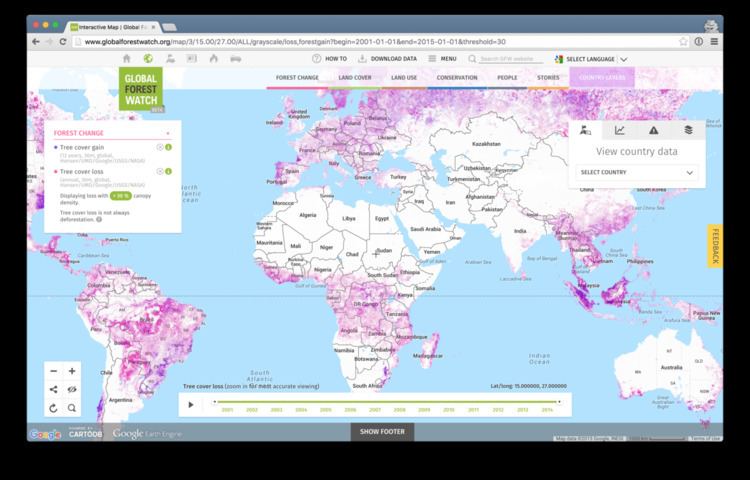Commercial No | Current status Online | |
 | ||
Website www.globalforestwatch.org Launched February 22, 2014; 3 years ago (2014-02-22) Written in HTML, Ruby, JavaScript, CSS, Shell | ||
Global Forest Watch (GFW) is an open-source web application to monitor global forests in near real-time. GFW is an initiative of the World Resources Institute (WRI), with partners including Google, USAID, the University of Maryland (UMD), Esri, and many other academic, non-profit, public, and private organizations.
Contents
History
Global Forest Watch originally began in 1997 as an initiative to establish a global forest monitoring network, convened by the World Resources Institute and partners.
The initiative was rebooted in 2013 with data from the Center for Global Development derived from NASA's MODIS sensor, with additional layers subsequently added from Google/UMD, Imazon, Terra-i, and NASA. The second iteration of GFW was released in February 2014, and continues to add information at multiple time scales and spatial resolutions to track deforestation. The GFW Commodities and GFW Fires sub-pages were subsequently released.
Use cases
The GFW platform has been used in a number of notable applications. The forest change data have been used to measure global deforestation rates and to detect and monitor illegal clearing activity, primarily in Indonesia. The NASA Active Fires data, displayed within GFW Fires, have been used to identify illegal burning that has caused the 2015 Southeast Asian haze crisis (see Haze crisis). Multinational companies use the GFW platform to track their supply chain, purportedly ensuring that they meet "no deforestation" commitments.
Data sets
There are currently five categories of data sets available on the GFW site, which are updated at various frequencies and available at various spatial resolutions.
Forest Change Data
Forest Cover Data
Forest Use Data
Conservation Data
People Data
Haze crisis
GFW contributed notable data and analysis to reporting on the 2015 Southeast Asian haze crisis, including revealing that approximately 35% of the fires in Indonesia occurred in agricultural concessions. This reporting linked the forest fires to specific companies.
